Strategic Analysis of Coca Cola
VerifiedAdded on 2023/04/04
|17
|3689
|366
AI Summary
This report provides a strategic analysis of Coca Cola, including its internal and external environment, SWOT analysis, competitor analysis, and e-commerce strategy. It discusses the organization's current market and positioning of its brand.
Contribute Materials
Your contribution can guide someone’s learning journey. Share your
documents today.
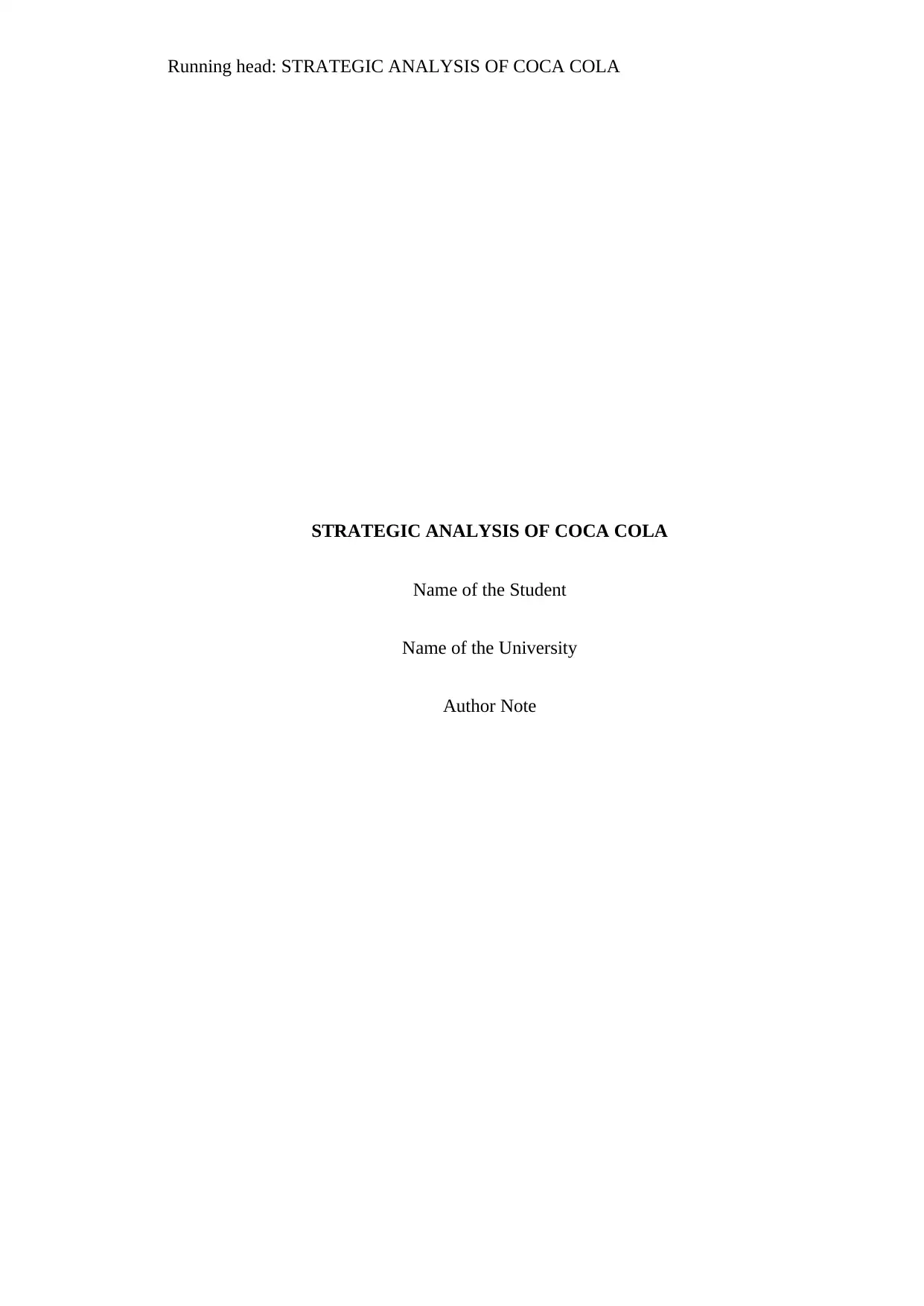
Running head: STRATEGIC ANALYSIS OF COCA COLA
STRATEGIC ANALYSIS OF COCA COLA
Name of the Student
Name of the University
Author Note
STRATEGIC ANALYSIS OF COCA COLA
Name of the Student
Name of the University
Author Note
Secure Best Marks with AI Grader
Need help grading? Try our AI Grader for instant feedback on your assignments.

1STRATEGIC ANALYSIS OF COCA COLA
Table of Contents
1. Executive Summary...................................................................................................2
2. Introduction or Background.......................................................................................2
3. Analysis of the organization (external or competitors)..............................................3
SWOT analysis of Coca Cola....................................................................................3
Competitor analysis of Coca Cola..............................................................................4
4. Strategy......................................................................................................................5
Current market of Coca Cola.....................................................................................7
Positioning of Coca Cola brand.................................................................................7
5. Action Plans...............................................................................................................8
6. Conclusion..................................................................................................................9
7. References................................................................................................................11
8. Appendices...............................................................................................................14
Appendix 1...............................................................................................................14
Appendix 2...............................................................................................................15
Table of Contents
1. Executive Summary...................................................................................................2
2. Introduction or Background.......................................................................................2
3. Analysis of the organization (external or competitors)..............................................3
SWOT analysis of Coca Cola....................................................................................3
Competitor analysis of Coca Cola..............................................................................4
4. Strategy......................................................................................................................5
Current market of Coca Cola.....................................................................................7
Positioning of Coca Cola brand.................................................................................7
5. Action Plans...............................................................................................................8
6. Conclusion..................................................................................................................9
7. References................................................................................................................11
8. Appendices...............................................................................................................14
Appendix 1...............................................................................................................14
Appendix 2...............................................................................................................15
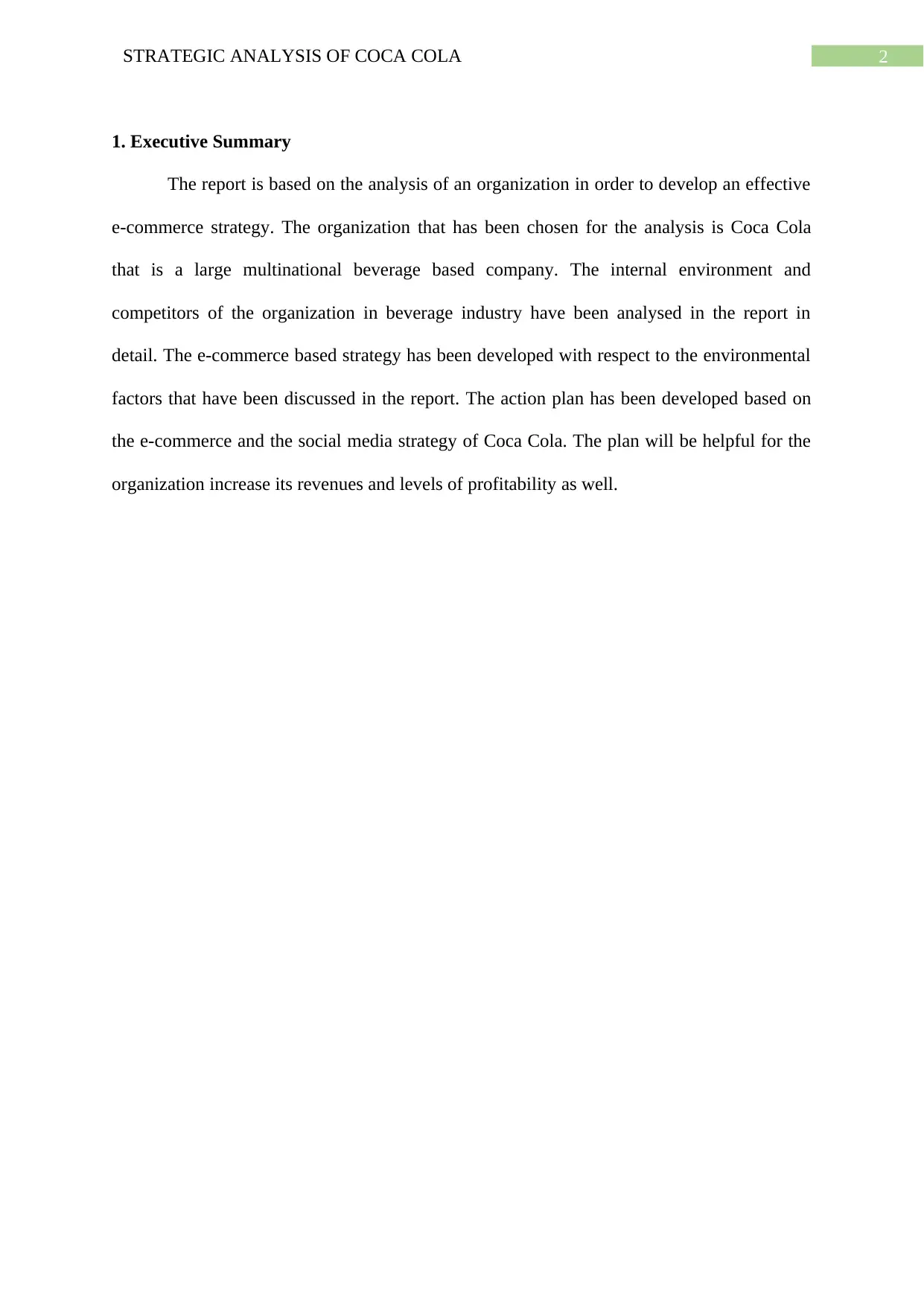
2STRATEGIC ANALYSIS OF COCA COLA
1. Executive Summary
The report is based on the analysis of an organization in order to develop an effective
e-commerce strategy. The organization that has been chosen for the analysis is Coca Cola
that is a large multinational beverage based company. The internal environment and
competitors of the organization in beverage industry have been analysed in the report in
detail. The e-commerce based strategy has been developed with respect to the environmental
factors that have been discussed in the report. The action plan has been developed based on
the e-commerce and the social media strategy of Coca Cola. The plan will be helpful for the
organization increase its revenues and levels of profitability as well.
1. Executive Summary
The report is based on the analysis of an organization in order to develop an effective
e-commerce strategy. The organization that has been chosen for the analysis is Coca Cola
that is a large multinational beverage based company. The internal environment and
competitors of the organization in beverage industry have been analysed in the report in
detail. The e-commerce based strategy has been developed with respect to the environmental
factors that have been discussed in the report. The action plan has been developed based on
the e-commerce and the social media strategy of Coca Cola. The plan will be helpful for the
organization increase its revenues and levels of profitability as well.
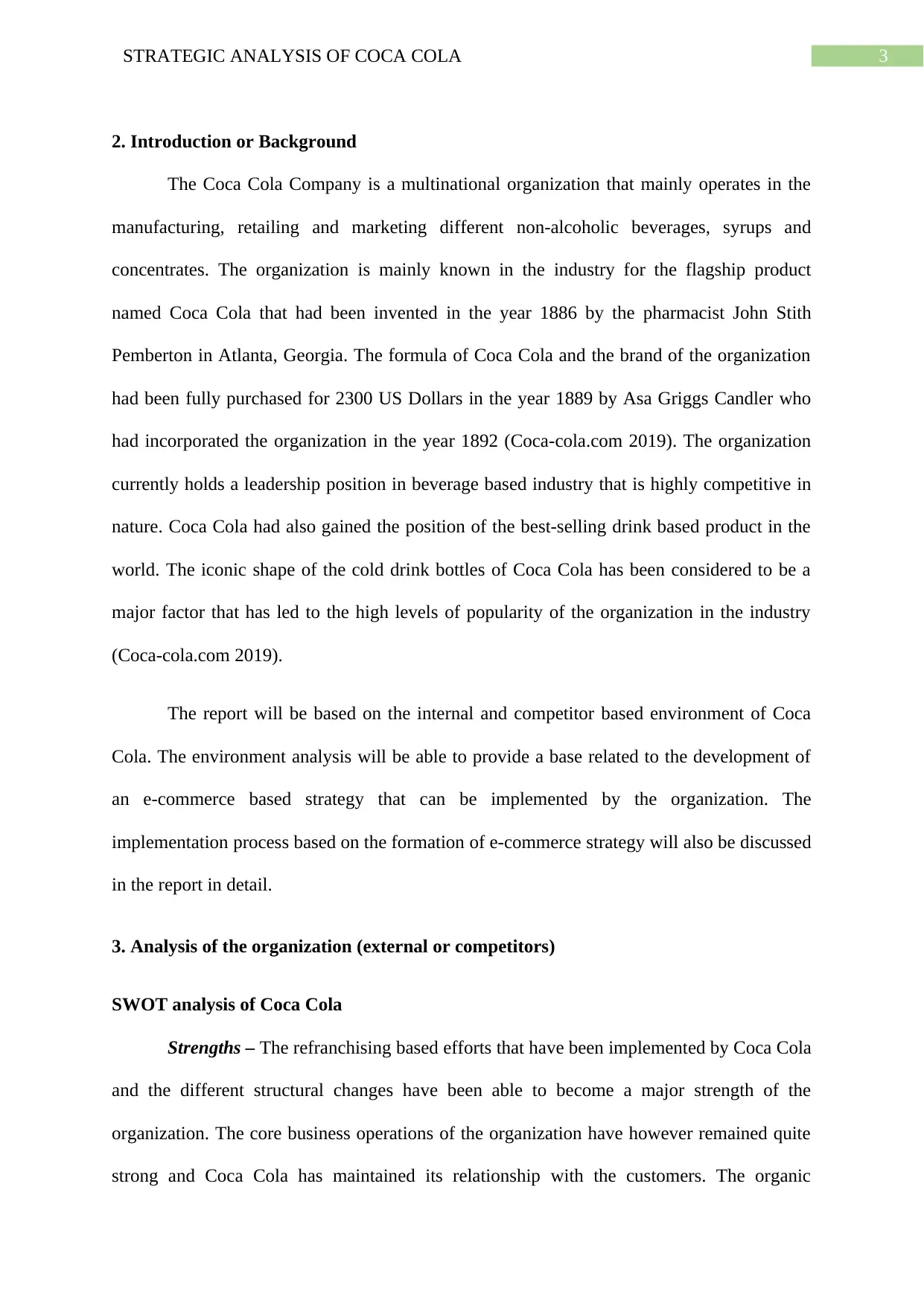
3STRATEGIC ANALYSIS OF COCA COLA
2. Introduction or Background
The Coca Cola Company is a multinational organization that mainly operates in the
manufacturing, retailing and marketing different non-alcoholic beverages, syrups and
concentrates. The organization is mainly known in the industry for the flagship product
named Coca Cola that had been invented in the year 1886 by the pharmacist John Stith
Pemberton in Atlanta, Georgia. The formula of Coca Cola and the brand of the organization
had been fully purchased for 2300 US Dollars in the year 1889 by Asa Griggs Candler who
had incorporated the organization in the year 1892 (Coca-cola.com 2019). The organization
currently holds a leadership position in beverage based industry that is highly competitive in
nature. Coca Cola had also gained the position of the best-selling drink based product in the
world. The iconic shape of the cold drink bottles of Coca Cola has been considered to be a
major factor that has led to the high levels of popularity of the organization in the industry
(Coca-cola.com 2019).
The report will be based on the internal and competitor based environment of Coca
Cola. The environment analysis will be able to provide a base related to the development of
an e-commerce based strategy that can be implemented by the organization. The
implementation process based on the formation of e-commerce strategy will also be discussed
in the report in detail.
3. Analysis of the organization (external or competitors)
SWOT analysis of Coca Cola
Strengths – The refranchising based efforts that have been implemented by Coca Cola
and the different structural changes have been able to become a major strength of the
organization. The core business operations of the organization have however remained quite
strong and Coca Cola has maintained its relationship with the customers. The organic
2. Introduction or Background
The Coca Cola Company is a multinational organization that mainly operates in the
manufacturing, retailing and marketing different non-alcoholic beverages, syrups and
concentrates. The organization is mainly known in the industry for the flagship product
named Coca Cola that had been invented in the year 1886 by the pharmacist John Stith
Pemberton in Atlanta, Georgia. The formula of Coca Cola and the brand of the organization
had been fully purchased for 2300 US Dollars in the year 1889 by Asa Griggs Candler who
had incorporated the organization in the year 1892 (Coca-cola.com 2019). The organization
currently holds a leadership position in beverage based industry that is highly competitive in
nature. Coca Cola had also gained the position of the best-selling drink based product in the
world. The iconic shape of the cold drink bottles of Coca Cola has been considered to be a
major factor that has led to the high levels of popularity of the organization in the industry
(Coca-cola.com 2019).
The report will be based on the internal and competitor based environment of Coca
Cola. The environment analysis will be able to provide a base related to the development of
an e-commerce based strategy that can be implemented by the organization. The
implementation process based on the formation of e-commerce strategy will also be discussed
in the report in detail.
3. Analysis of the organization (external or competitors)
SWOT analysis of Coca Cola
Strengths – The refranchising based efforts that have been implemented by Coca Cola
and the different structural changes have been able to become a major strength of the
organization. The core business operations of the organization have however remained quite
strong and Coca Cola has maintained its relationship with the customers. The organic
Secure Best Marks with AI Grader
Need help grading? Try our AI Grader for instant feedback on your assignments.

4STRATEGIC ANALYSIS OF COCA COLA
revenues that have been gained by Coca Cola has been predicted to grow in the year 2017
(Akter and Wamba 2016). The operating performance of the organization is also expected to
drive the growth in the beverage based industry. Coca Cola has been capable of being
recognised as a major global brand and the awareness of the products is present in more than
90% of the total population in the world. The topmost rank has been provided to Coca Cola
based on multicultural opportunities and operations within the organization (Barrutia, Paredes
and Echebarria 2016).
Weaknesses – The core performance that is developed by Coca Cola has been quite
solid in spite of the different structural changes, however, the earnings per share that had
been gained by the organization had a major impact on the operations of the organization in
different countries. The levels of uncertainty have increased due to changes that have been
implemented in the structure and plans based on refranchising as well. The strategies that
have been implemented by the organization in the e-commerce operations have also changed
due to structural changes (Blázquez Soriano et al. 2016).
Opportunities – Coca Cola however has major levels of opportunities in order to
develop the operations and revenues of the organization as well. The ways by which Coca
Cola aims to adapt its operations to the changes that have taken place in the behaviour of
consumers have been able to play a major role in the growth of revenues of the organization
(Bones and Hammersley 2015). The organization has already started taking major steps in
order to improve the types of products and make them more sustainable in nature. The focus
of the organization on circular economy is an important factor that has an impact on the
development of competitive advantage in the beverage industry (Chang et al. 2016).
Threats – The sustainability based methods that are implemented by Coca Cola have
not been able to affect the customer base of the organization in a positive manner. The
revenues that have been gained by Coca Cola has been predicted to grow in the year 2017
(Akter and Wamba 2016). The operating performance of the organization is also expected to
drive the growth in the beverage based industry. Coca Cola has been capable of being
recognised as a major global brand and the awareness of the products is present in more than
90% of the total population in the world. The topmost rank has been provided to Coca Cola
based on multicultural opportunities and operations within the organization (Barrutia, Paredes
and Echebarria 2016).
Weaknesses – The core performance that is developed by Coca Cola has been quite
solid in spite of the different structural changes, however, the earnings per share that had
been gained by the organization had a major impact on the operations of the organization in
different countries. The levels of uncertainty have increased due to changes that have been
implemented in the structure and plans based on refranchising as well. The strategies that
have been implemented by the organization in the e-commerce operations have also changed
due to structural changes (Blázquez Soriano et al. 2016).
Opportunities – Coca Cola however has major levels of opportunities in order to
develop the operations and revenues of the organization as well. The ways by which Coca
Cola aims to adapt its operations to the changes that have taken place in the behaviour of
consumers have been able to play a major role in the growth of revenues of the organization
(Bones and Hammersley 2015). The organization has already started taking major steps in
order to improve the types of products and make them more sustainable in nature. The focus
of the organization on circular economy is an important factor that has an impact on the
development of competitive advantage in the beverage industry (Chang et al. 2016).
Threats – The sustainability based methods that are implemented by Coca Cola have
not been able to affect the customer base of the organization in a positive manner. The

5STRATEGIC ANALYSIS OF COCA COLA
customers have considered the steps based on sustainability implemented by Coca Cola to be
greenwashing. The visibility levels of Coca Cola in the e-commerce based operations are low
and this is considered to be a major threat based on the operations that have been developed
by the organization (Cui and Pan 2015).
Competitor analysis of Coca Cola
The Coca Cola Company has gained the position of the biggest on non-alcoholic
beverage based organization in the industry. Nestle and PepsiCo can be considered to be two
of most significant competitors of Coca Cola. The size of the organization and the share that
has been gained by Coca Cola is based on the dominance that has been developed in the
beverage industry. The company has however faced major levels of competition based on the
levels of profitability that has been gained in the beverage based industry (Effing and Spil
2016). The Coca Cola Company has gained major levels of advantages based on the
economies of scale. The other competitors of Coca Cola in the industry include, Red Bull,
Diet Coke, Fanta, Sprite, Gatorade, Dr. Pepper, Mountain Dew, Lipton, Nescafe, Tropicana.
The intense competitive environment in which Coca Cola operates is considered to be a
major factor that has led to the changes that have been implemented in the processes (Kaptein
and Parvinen 2015). The organizations have provided major levels of competition to The
Coca Cola Company based on the levels of operations. The value proposition that has been
developed by the organization is also based on the development of the leadership position of
Coca Cola in the industry. The e-commerce operations have however not been able to
provide support to the organization based on the ways by which it can maintain its position.
The strengths related to the brand value of The Coca Cola Company have been able to play a
major role in the formation of a position of the organization (Laudon and Traver 2016).
customers have considered the steps based on sustainability implemented by Coca Cola to be
greenwashing. The visibility levels of Coca Cola in the e-commerce based operations are low
and this is considered to be a major threat based on the operations that have been developed
by the organization (Cui and Pan 2015).
Competitor analysis of Coca Cola
The Coca Cola Company has gained the position of the biggest on non-alcoholic
beverage based organization in the industry. Nestle and PepsiCo can be considered to be two
of most significant competitors of Coca Cola. The size of the organization and the share that
has been gained by Coca Cola is based on the dominance that has been developed in the
beverage industry. The company has however faced major levels of competition based on the
levels of profitability that has been gained in the beverage based industry (Effing and Spil
2016). The Coca Cola Company has gained major levels of advantages based on the
economies of scale. The other competitors of Coca Cola in the industry include, Red Bull,
Diet Coke, Fanta, Sprite, Gatorade, Dr. Pepper, Mountain Dew, Lipton, Nescafe, Tropicana.
The intense competitive environment in which Coca Cola operates is considered to be a
major factor that has led to the changes that have been implemented in the processes (Kaptein
and Parvinen 2015). The organizations have provided major levels of competition to The
Coca Cola Company based on the levels of operations. The value proposition that has been
developed by the organization is also based on the development of the leadership position of
Coca Cola in the industry. The e-commerce operations have however not been able to
provide support to the organization based on the ways by which it can maintain its position.
The strengths related to the brand value of The Coca Cola Company have been able to play a
major role in the formation of a position of the organization (Laudon and Traver 2016).
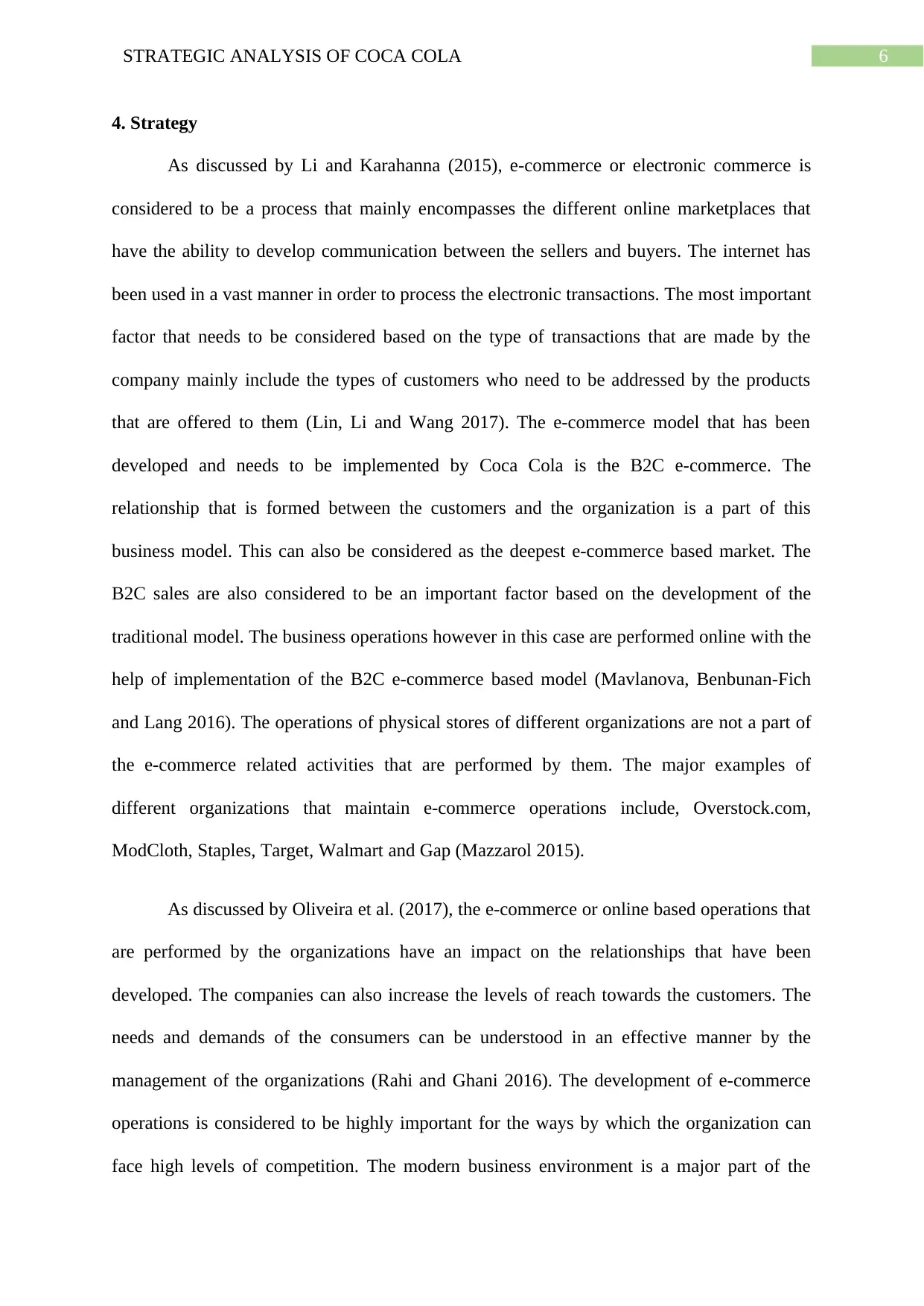
6STRATEGIC ANALYSIS OF COCA COLA
4. Strategy
As discussed by Li and Karahanna (2015), e-commerce or electronic commerce is
considered to be a process that mainly encompasses the different online marketplaces that
have the ability to develop communication between the sellers and buyers. The internet has
been used in a vast manner in order to process the electronic transactions. The most important
factor that needs to be considered based on the type of transactions that are made by the
company mainly include the types of customers who need to be addressed by the products
that are offered to them (Lin, Li and Wang 2017). The e-commerce model that has been
developed and needs to be implemented by Coca Cola is the B2C e-commerce. The
relationship that is formed between the customers and the organization is a part of this
business model. This can also be considered as the deepest e-commerce based market. The
B2C sales are also considered to be an important factor based on the development of the
traditional model. The business operations however in this case are performed online with the
help of implementation of the B2C e-commerce based model (Mavlanova, Benbunan-Fich
and Lang 2016). The operations of physical stores of different organizations are not a part of
the e-commerce related activities that are performed by them. The major examples of
different organizations that maintain e-commerce operations include, Overstock.com,
ModCloth, Staples, Target, Walmart and Gap (Mazzarol 2015).
As discussed by Oliveira et al. (2017), the e-commerce or online based operations that
are performed by the organizations have an impact on the relationships that have been
developed. The companies can also increase the levels of reach towards the customers. The
needs and demands of the consumers can be understood in an effective manner by the
management of the organizations (Rahi and Ghani 2016). The development of e-commerce
operations is considered to be highly important for the ways by which the organization can
face high levels of competition. The modern business environment is a major part of the
4. Strategy
As discussed by Li and Karahanna (2015), e-commerce or electronic commerce is
considered to be a process that mainly encompasses the different online marketplaces that
have the ability to develop communication between the sellers and buyers. The internet has
been used in a vast manner in order to process the electronic transactions. The most important
factor that needs to be considered based on the type of transactions that are made by the
company mainly include the types of customers who need to be addressed by the products
that are offered to them (Lin, Li and Wang 2017). The e-commerce model that has been
developed and needs to be implemented by Coca Cola is the B2C e-commerce. The
relationship that is formed between the customers and the organization is a part of this
business model. This can also be considered as the deepest e-commerce based market. The
B2C sales are also considered to be an important factor based on the development of the
traditional model. The business operations however in this case are performed online with the
help of implementation of the B2C e-commerce based model (Mavlanova, Benbunan-Fich
and Lang 2016). The operations of physical stores of different organizations are not a part of
the e-commerce related activities that are performed by them. The major examples of
different organizations that maintain e-commerce operations include, Overstock.com,
ModCloth, Staples, Target, Walmart and Gap (Mazzarol 2015).
As discussed by Oliveira et al. (2017), the e-commerce or online based operations that
are performed by the organizations have an impact on the relationships that have been
developed. The companies can also increase the levels of reach towards the customers. The
needs and demands of the consumers can be understood in an effective manner by the
management of the organizations (Rahi and Ghani 2016). The development of e-commerce
operations is considered to be highly important for the ways by which the organization can
face high levels of competition. The modern business environment is a major part of the
Paraphrase This Document
Need a fresh take? Get an instant paraphrase of this document with our AI Paraphraser
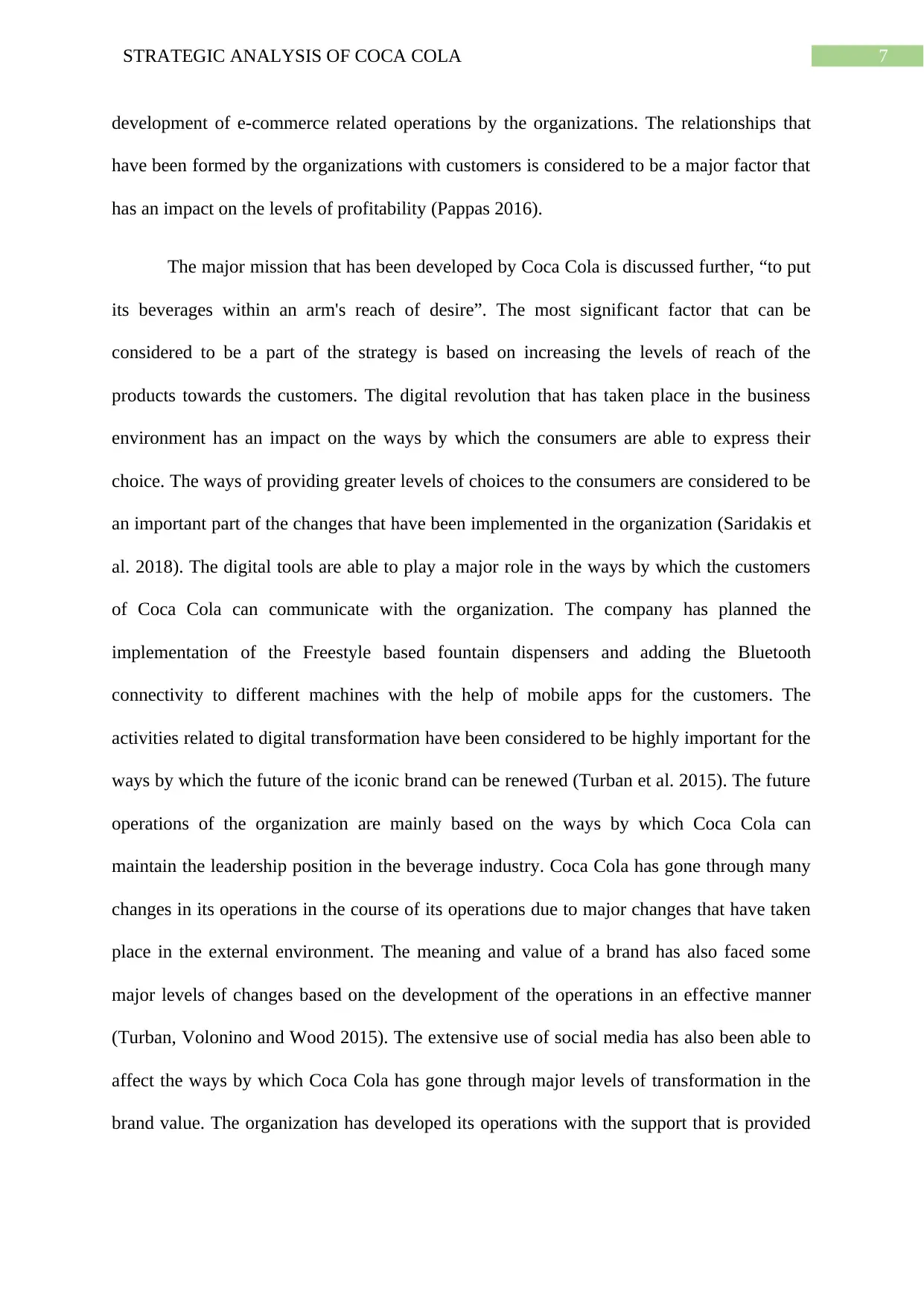
7STRATEGIC ANALYSIS OF COCA COLA
development of e-commerce related operations by the organizations. The relationships that
have been formed by the organizations with customers is considered to be a major factor that
has an impact on the levels of profitability (Pappas 2016).
The major mission that has been developed by Coca Cola is discussed further, “to put
its beverages within an arm's reach of desire”. The most significant factor that can be
considered to be a part of the strategy is based on increasing the levels of reach of the
products towards the customers. The digital revolution that has taken place in the business
environment has an impact on the ways by which the consumers are able to express their
choice. The ways of providing greater levels of choices to the consumers are considered to be
an important part of the changes that have been implemented in the organization (Saridakis et
al. 2018). The digital tools are able to play a major role in the ways by which the customers
of Coca Cola can communicate with the organization. The company has planned the
implementation of the Freestyle based fountain dispensers and adding the Bluetooth
connectivity to different machines with the help of mobile apps for the customers. The
activities related to digital transformation have been considered to be highly important for the
ways by which the future of the iconic brand can be renewed (Turban et al. 2015). The future
operations of the organization are mainly based on the ways by which Coca Cola can
maintain the leadership position in the beverage industry. Coca Cola has gone through many
changes in its operations in the course of its operations due to major changes that have taken
place in the external environment. The meaning and value of a brand has also faced some
major levels of changes based on the development of the operations in an effective manner
(Turban, Volonino and Wood 2015). The extensive use of social media has also been able to
affect the ways by which Coca Cola has gone through major levels of transformation in the
brand value. The organization has developed its operations with the support that is provided
development of e-commerce related operations by the organizations. The relationships that
have been formed by the organizations with customers is considered to be a major factor that
has an impact on the levels of profitability (Pappas 2016).
The major mission that has been developed by Coca Cola is discussed further, “to put
its beverages within an arm's reach of desire”. The most significant factor that can be
considered to be a part of the strategy is based on increasing the levels of reach of the
products towards the customers. The digital revolution that has taken place in the business
environment has an impact on the ways by which the consumers are able to express their
choice. The ways of providing greater levels of choices to the consumers are considered to be
an important part of the changes that have been implemented in the organization (Saridakis et
al. 2018). The digital tools are able to play a major role in the ways by which the customers
of Coca Cola can communicate with the organization. The company has planned the
implementation of the Freestyle based fountain dispensers and adding the Bluetooth
connectivity to different machines with the help of mobile apps for the customers. The
activities related to digital transformation have been considered to be highly important for the
ways by which the future of the iconic brand can be renewed (Turban et al. 2015). The future
operations of the organization are mainly based on the ways by which Coca Cola can
maintain the leadership position in the beverage industry. Coca Cola has gone through many
changes in its operations in the course of its operations due to major changes that have taken
place in the external environment. The meaning and value of a brand has also faced some
major levels of changes based on the development of the operations in an effective manner
(Turban, Volonino and Wood 2015). The extensive use of social media has also been able to
affect the ways by which Coca Cola has gone through major levels of transformation in the
brand value. The organization has developed its operations with the support that is provided
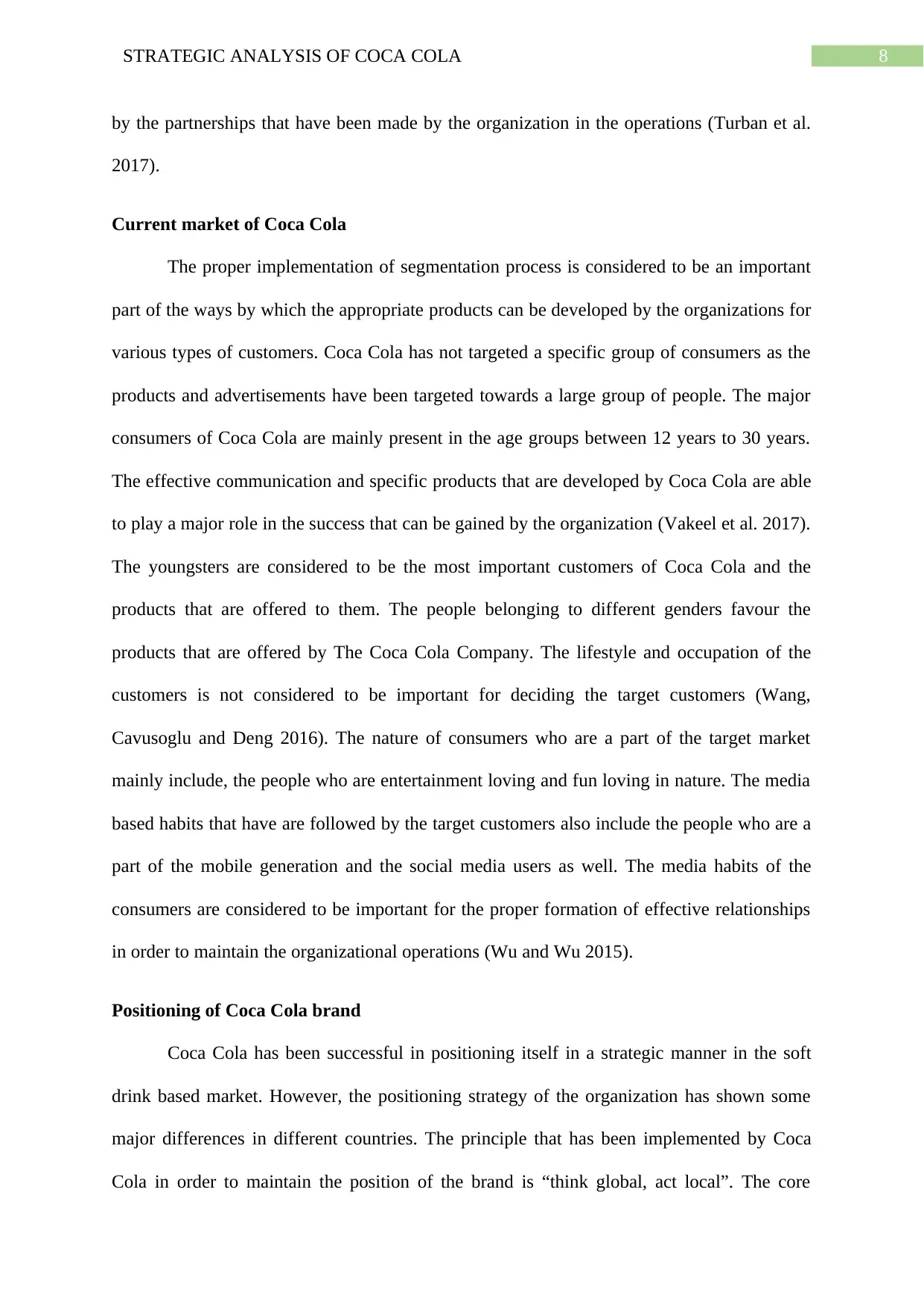
8STRATEGIC ANALYSIS OF COCA COLA
by the partnerships that have been made by the organization in the operations (Turban et al.
2017).
Current market of Coca Cola
The proper implementation of segmentation process is considered to be an important
part of the ways by which the appropriate products can be developed by the organizations for
various types of customers. Coca Cola has not targeted a specific group of consumers as the
products and advertisements have been targeted towards a large group of people. The major
consumers of Coca Cola are mainly present in the age groups between 12 years to 30 years.
The effective communication and specific products that are developed by Coca Cola are able
to play a major role in the success that can be gained by the organization (Vakeel et al. 2017).
The youngsters are considered to be the most important customers of Coca Cola and the
products that are offered to them. The people belonging to different genders favour the
products that are offered by The Coca Cola Company. The lifestyle and occupation of the
customers is not considered to be important for deciding the target customers (Wang,
Cavusoglu and Deng 2016). The nature of consumers who are a part of the target market
mainly include, the people who are entertainment loving and fun loving in nature. The media
based habits that have are followed by the target customers also include the people who are a
part of the mobile generation and the social media users as well. The media habits of the
consumers are considered to be important for the proper formation of effective relationships
in order to maintain the organizational operations (Wu and Wu 2015).
Positioning of Coca Cola brand
Coca Cola has been successful in positioning itself in a strategic manner in the soft
drink based market. However, the positioning strategy of the organization has shown some
major differences in different countries. The principle that has been implemented by Coca
Cola in order to maintain the position of the brand is “think global, act local”. The core
by the partnerships that have been made by the organization in the operations (Turban et al.
2017).
Current market of Coca Cola
The proper implementation of segmentation process is considered to be an important
part of the ways by which the appropriate products can be developed by the organizations for
various types of customers. Coca Cola has not targeted a specific group of consumers as the
products and advertisements have been targeted towards a large group of people. The major
consumers of Coca Cola are mainly present in the age groups between 12 years to 30 years.
The effective communication and specific products that are developed by Coca Cola are able
to play a major role in the success that can be gained by the organization (Vakeel et al. 2017).
The youngsters are considered to be the most important customers of Coca Cola and the
products that are offered to them. The people belonging to different genders favour the
products that are offered by The Coca Cola Company. The lifestyle and occupation of the
customers is not considered to be important for deciding the target customers (Wang,
Cavusoglu and Deng 2016). The nature of consumers who are a part of the target market
mainly include, the people who are entertainment loving and fun loving in nature. The media
based habits that have are followed by the target customers also include the people who are a
part of the mobile generation and the social media users as well. The media habits of the
consumers are considered to be important for the proper formation of effective relationships
in order to maintain the organizational operations (Wu and Wu 2015).
Positioning of Coca Cola brand
Coca Cola has been successful in positioning itself in a strategic manner in the soft
drink based market. However, the positioning strategy of the organization has shown some
major differences in different countries. The principle that has been implemented by Coca
Cola in order to maintain the position of the brand is “think global, act local”. The core

9STRATEGIC ANALYSIS OF COCA COLA
product of the organization is sold to the customers keeping in mind the local needs as well
(Wang, Cavusoglu and Deng 2016). The concept of strategic positioning is implemented by
the organization in order to develop and maintain its position in different countries. Coca
Cola has been perceived to be a part of the lives of people in different parts of the world. The
connection that has been formed by the organization with the customers is thereby considered
to be an important part of the strategies that are implemented in the operations (Vakeel et al.
2017). The relationship developed by Coca Cola with the help of its brand is also able to
affect the purchase decision that is taken by the customers. The organization has been
successful in the development of a loyal customer base with the connections that are
developed by the products (Turban, Volonino and Wood 2015).
The topmost position that has been formed by Coca Cola in the beverage industry has
been able to play a major role in the ways by which the organization has developed the loyal
base of customers. The e-commerce business model will be able to provide major levels of
support to the organization in terms of increase in the levels of revenues and profitability as
well. The major e-commerce strategy that can be implemented by Coca Cola in order to
further improve the relationships developed with the customers is based on the development
of an effective social media strategy (Mavlanova, Benbunan-Fich and Lang 2016). Social
media platforms like Facebook, Twitter and YouTube will be able to provide a major role in
supporting the operations and relationships formed by the modern organizations. Coca Cola
has already developed major social media strategies that have been helpful for the
organization to send its messages to the customers. The development of the strategy however
will be able to play a major role in the effective improvement of the ways by which the
organization is able to maintain its operations (Mazzarol 2015).
product of the organization is sold to the customers keeping in mind the local needs as well
(Wang, Cavusoglu and Deng 2016). The concept of strategic positioning is implemented by
the organization in order to develop and maintain its position in different countries. Coca
Cola has been perceived to be a part of the lives of people in different parts of the world. The
connection that has been formed by the organization with the customers is thereby considered
to be an important part of the strategies that are implemented in the operations (Vakeel et al.
2017). The relationship developed by Coca Cola with the help of its brand is also able to
affect the purchase decision that is taken by the customers. The organization has been
successful in the development of a loyal customer base with the connections that are
developed by the products (Turban, Volonino and Wood 2015).
The topmost position that has been formed by Coca Cola in the beverage industry has
been able to play a major role in the ways by which the organization has developed the loyal
base of customers. The e-commerce business model will be able to provide major levels of
support to the organization in terms of increase in the levels of revenues and profitability as
well. The major e-commerce strategy that can be implemented by Coca Cola in order to
further improve the relationships developed with the customers is based on the development
of an effective social media strategy (Mavlanova, Benbunan-Fich and Lang 2016). Social
media platforms like Facebook, Twitter and YouTube will be able to provide a major role in
supporting the operations and relationships formed by the modern organizations. Coca Cola
has already developed major social media strategies that have been helpful for the
organization to send its messages to the customers. The development of the strategy however
will be able to play a major role in the effective improvement of the ways by which the
organization is able to maintain its operations (Mazzarol 2015).
Secure Best Marks with AI Grader
Need help grading? Try our AI Grader for instant feedback on your assignments.
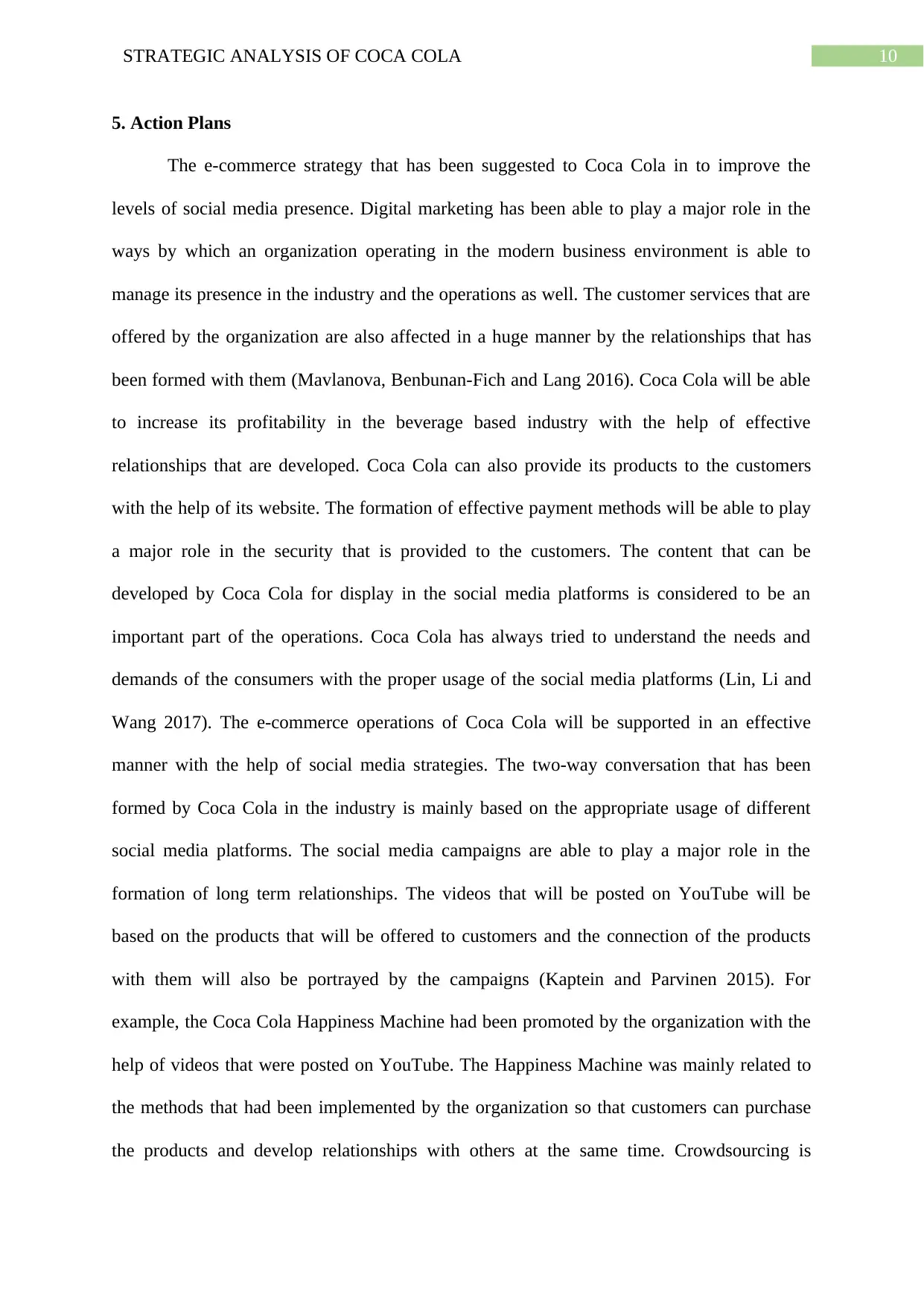
10STRATEGIC ANALYSIS OF COCA COLA
5. Action Plans
The e-commerce strategy that has been suggested to Coca Cola in to improve the
levels of social media presence. Digital marketing has been able to play a major role in the
ways by which an organization operating in the modern business environment is able to
manage its presence in the industry and the operations as well. The customer services that are
offered by the organization are also affected in a huge manner by the relationships that has
been formed with them (Mavlanova, Benbunan-Fich and Lang 2016). Coca Cola will be able
to increase its profitability in the beverage based industry with the help of effective
relationships that are developed. Coca Cola can also provide its products to the customers
with the help of its website. The formation of effective payment methods will be able to play
a major role in the security that is provided to the customers. The content that can be
developed by Coca Cola for display in the social media platforms is considered to be an
important part of the operations. Coca Cola has always tried to understand the needs and
demands of the consumers with the proper usage of the social media platforms (Lin, Li and
Wang 2017). The e-commerce operations of Coca Cola will be supported in an effective
manner with the help of social media strategies. The two-way conversation that has been
formed by Coca Cola in the industry is mainly based on the appropriate usage of different
social media platforms. The social media campaigns are able to play a major role in the
formation of long term relationships. The videos that will be posted on YouTube will be
based on the products that will be offered to customers and the connection of the products
with them will also be portrayed by the campaigns (Kaptein and Parvinen 2015). For
example, the Coca Cola Happiness Machine had been promoted by the organization with the
help of videos that were posted on YouTube. The Happiness Machine was mainly related to
the methods that had been implemented by the organization so that customers can purchase
the products and develop relationships with others at the same time. Crowdsourcing is
5. Action Plans
The e-commerce strategy that has been suggested to Coca Cola in to improve the
levels of social media presence. Digital marketing has been able to play a major role in the
ways by which an organization operating in the modern business environment is able to
manage its presence in the industry and the operations as well. The customer services that are
offered by the organization are also affected in a huge manner by the relationships that has
been formed with them (Mavlanova, Benbunan-Fich and Lang 2016). Coca Cola will be able
to increase its profitability in the beverage based industry with the help of effective
relationships that are developed. Coca Cola can also provide its products to the customers
with the help of its website. The formation of effective payment methods will be able to play
a major role in the security that is provided to the customers. The content that can be
developed by Coca Cola for display in the social media platforms is considered to be an
important part of the operations. Coca Cola has always tried to understand the needs and
demands of the consumers with the proper usage of the social media platforms (Lin, Li and
Wang 2017). The e-commerce operations of Coca Cola will be supported in an effective
manner with the help of social media strategies. The two-way conversation that has been
formed by Coca Cola in the industry is mainly based on the appropriate usage of different
social media platforms. The social media campaigns are able to play a major role in the
formation of long term relationships. The videos that will be posted on YouTube will be
based on the products that will be offered to customers and the connection of the products
with them will also be portrayed by the campaigns (Kaptein and Parvinen 2015). For
example, the Coca Cola Happiness Machine had been promoted by the organization with the
help of videos that were posted on YouTube. The Happiness Machine was mainly related to
the methods that had been implemented by the organization so that customers can purchase
the products and develop relationships with others at the same time. Crowdsourcing is

11STRATEGIC ANALYSIS OF COCA COLA
another major benefit that is offered by Coca Cola with the help of social media platforms.
Coca Cola will be able to use the information and data of the customers in order to
understand their demands and preferences (Rahi and Ghani 2016).
6. Conclusion
The report can be concluded by stating that the operations of Coca Cola in the
beverage industry can be improved with the help of proper improvement of the e-commerce
operations. The social media strategy will be able to play a major role in the ways by which
Coca Cola can improve the operations in the beverage industry. The data of customers will be
used by the company in order to develop the strategies that can help in increasing the levels
of profitability and also to maintain its leadership position in a sustainable manner.
another major benefit that is offered by Coca Cola with the help of social media platforms.
Coca Cola will be able to use the information and data of the customers in order to
understand their demands and preferences (Rahi and Ghani 2016).
6. Conclusion
The report can be concluded by stating that the operations of Coca Cola in the
beverage industry can be improved with the help of proper improvement of the e-commerce
operations. The social media strategy will be able to play a major role in the ways by which
Coca Cola can improve the operations in the beverage industry. The data of customers will be
used by the company in order to develop the strategies that can help in increasing the levels
of profitability and also to maintain its leadership position in a sustainable manner.
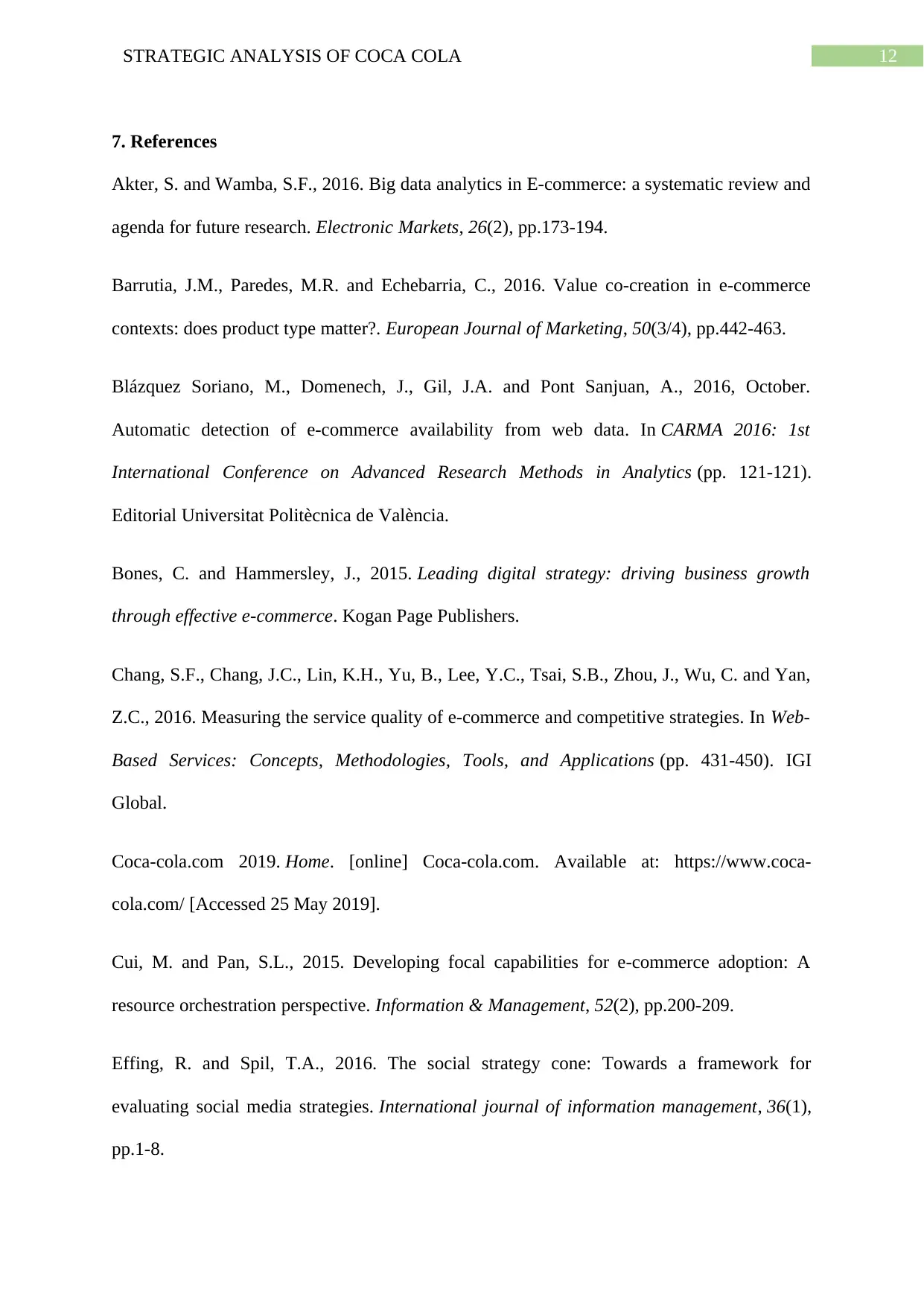
12STRATEGIC ANALYSIS OF COCA COLA
7. References
Akter, S. and Wamba, S.F., 2016. Big data analytics in E-commerce: a systematic review and
agenda for future research. Electronic Markets, 26(2), pp.173-194.
Barrutia, J.M., Paredes, M.R. and Echebarria, C., 2016. Value co-creation in e-commerce
contexts: does product type matter?. European Journal of Marketing, 50(3/4), pp.442-463.
Blázquez Soriano, M., Domenech, J., Gil, J.A. and Pont Sanjuan, A., 2016, October.
Automatic detection of e-commerce availability from web data. In CARMA 2016: 1st
International Conference on Advanced Research Methods in Analytics (pp. 121-121).
Editorial Universitat Politècnica de València.
Bones, C. and Hammersley, J., 2015. Leading digital strategy: driving business growth
through effective e-commerce. Kogan Page Publishers.
Chang, S.F., Chang, J.C., Lin, K.H., Yu, B., Lee, Y.C., Tsai, S.B., Zhou, J., Wu, C. and Yan,
Z.C., 2016. Measuring the service quality of e-commerce and competitive strategies. In Web-
Based Services: Concepts, Methodologies, Tools, and Applications (pp. 431-450). IGI
Global.
Coca-cola.com 2019. Home. [online] Coca-cola.com. Available at: https://www.coca-
cola.com/ [Accessed 25 May 2019].
Cui, M. and Pan, S.L., 2015. Developing focal capabilities for e-commerce adoption: A
resource orchestration perspective. Information & Management, 52(2), pp.200-209.
Effing, R. and Spil, T.A., 2016. The social strategy cone: Towards a framework for
evaluating social media strategies. International journal of information management, 36(1),
pp.1-8.
7. References
Akter, S. and Wamba, S.F., 2016. Big data analytics in E-commerce: a systematic review and
agenda for future research. Electronic Markets, 26(2), pp.173-194.
Barrutia, J.M., Paredes, M.R. and Echebarria, C., 2016. Value co-creation in e-commerce
contexts: does product type matter?. European Journal of Marketing, 50(3/4), pp.442-463.
Blázquez Soriano, M., Domenech, J., Gil, J.A. and Pont Sanjuan, A., 2016, October.
Automatic detection of e-commerce availability from web data. In CARMA 2016: 1st
International Conference on Advanced Research Methods in Analytics (pp. 121-121).
Editorial Universitat Politècnica de València.
Bones, C. and Hammersley, J., 2015. Leading digital strategy: driving business growth
through effective e-commerce. Kogan Page Publishers.
Chang, S.F., Chang, J.C., Lin, K.H., Yu, B., Lee, Y.C., Tsai, S.B., Zhou, J., Wu, C. and Yan,
Z.C., 2016. Measuring the service quality of e-commerce and competitive strategies. In Web-
Based Services: Concepts, Methodologies, Tools, and Applications (pp. 431-450). IGI
Global.
Coca-cola.com 2019. Home. [online] Coca-cola.com. Available at: https://www.coca-
cola.com/ [Accessed 25 May 2019].
Cui, M. and Pan, S.L., 2015. Developing focal capabilities for e-commerce adoption: A
resource orchestration perspective. Information & Management, 52(2), pp.200-209.
Effing, R. and Spil, T.A., 2016. The social strategy cone: Towards a framework for
evaluating social media strategies. International journal of information management, 36(1),
pp.1-8.
Paraphrase This Document
Need a fresh take? Get an instant paraphrase of this document with our AI Paraphraser
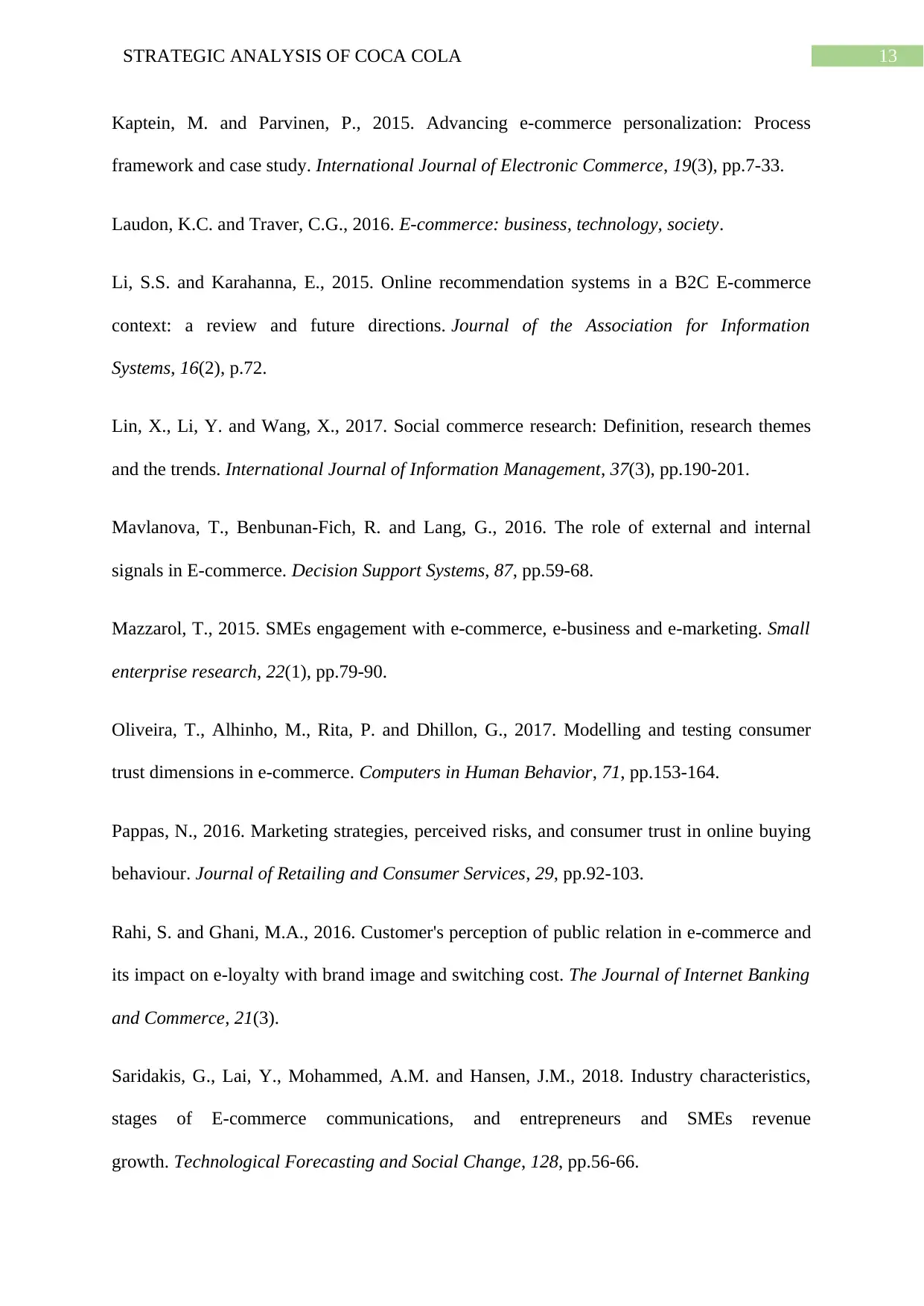
13STRATEGIC ANALYSIS OF COCA COLA
Kaptein, M. and Parvinen, P., 2015. Advancing e-commerce personalization: Process
framework and case study. International Journal of Electronic Commerce, 19(3), pp.7-33.
Laudon, K.C. and Traver, C.G., 2016. E-commerce: business, technology, society.
Li, S.S. and Karahanna, E., 2015. Online recommendation systems in a B2C E-commerce
context: a review and future directions. Journal of the Association for Information
Systems, 16(2), p.72.
Lin, X., Li, Y. and Wang, X., 2017. Social commerce research: Definition, research themes
and the trends. International Journal of Information Management, 37(3), pp.190-201.
Mavlanova, T., Benbunan-Fich, R. and Lang, G., 2016. The role of external and internal
signals in E-commerce. Decision Support Systems, 87, pp.59-68.
Mazzarol, T., 2015. SMEs engagement with e-commerce, e-business and e-marketing. Small
enterprise research, 22(1), pp.79-90.
Oliveira, T., Alhinho, M., Rita, P. and Dhillon, G., 2017. Modelling and testing consumer
trust dimensions in e-commerce. Computers in Human Behavior, 71, pp.153-164.
Pappas, N., 2016. Marketing strategies, perceived risks, and consumer trust in online buying
behaviour. Journal of Retailing and Consumer Services, 29, pp.92-103.
Rahi, S. and Ghani, M.A., 2016. Customer's perception of public relation in e-commerce and
its impact on e-loyalty with brand image and switching cost. The Journal of Internet Banking
and Commerce, 21(3).
Saridakis, G., Lai, Y., Mohammed, A.M. and Hansen, J.M., 2018. Industry characteristics,
stages of E-commerce communications, and entrepreneurs and SMEs revenue
growth. Technological Forecasting and Social Change, 128, pp.56-66.
Kaptein, M. and Parvinen, P., 2015. Advancing e-commerce personalization: Process
framework and case study. International Journal of Electronic Commerce, 19(3), pp.7-33.
Laudon, K.C. and Traver, C.G., 2016. E-commerce: business, technology, society.
Li, S.S. and Karahanna, E., 2015. Online recommendation systems in a B2C E-commerce
context: a review and future directions. Journal of the Association for Information
Systems, 16(2), p.72.
Lin, X., Li, Y. and Wang, X., 2017. Social commerce research: Definition, research themes
and the trends. International Journal of Information Management, 37(3), pp.190-201.
Mavlanova, T., Benbunan-Fich, R. and Lang, G., 2016. The role of external and internal
signals in E-commerce. Decision Support Systems, 87, pp.59-68.
Mazzarol, T., 2015. SMEs engagement with e-commerce, e-business and e-marketing. Small
enterprise research, 22(1), pp.79-90.
Oliveira, T., Alhinho, M., Rita, P. and Dhillon, G., 2017. Modelling and testing consumer
trust dimensions in e-commerce. Computers in Human Behavior, 71, pp.153-164.
Pappas, N., 2016. Marketing strategies, perceived risks, and consumer trust in online buying
behaviour. Journal of Retailing and Consumer Services, 29, pp.92-103.
Rahi, S. and Ghani, M.A., 2016. Customer's perception of public relation in e-commerce and
its impact on e-loyalty with brand image and switching cost. The Journal of Internet Banking
and Commerce, 21(3).
Saridakis, G., Lai, Y., Mohammed, A.M. and Hansen, J.M., 2018. Industry characteristics,
stages of E-commerce communications, and entrepreneurs and SMEs revenue
growth. Technological Forecasting and Social Change, 128, pp.56-66.
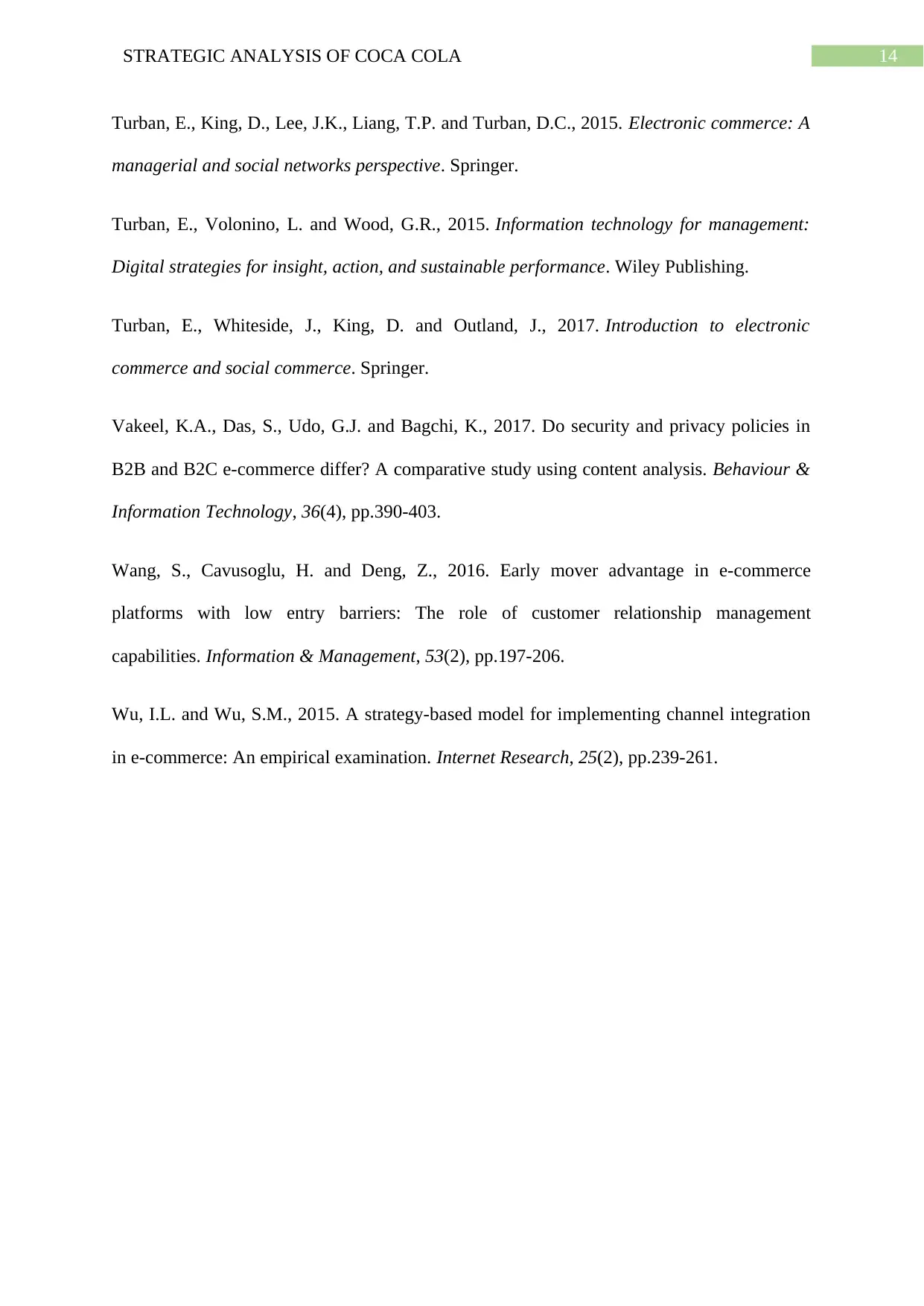
14STRATEGIC ANALYSIS OF COCA COLA
Turban, E., King, D., Lee, J.K., Liang, T.P. and Turban, D.C., 2015. Electronic commerce: A
managerial and social networks perspective. Springer.
Turban, E., Volonino, L. and Wood, G.R., 2015. Information technology for management:
Digital strategies for insight, action, and sustainable performance. Wiley Publishing.
Turban, E., Whiteside, J., King, D. and Outland, J., 2017. Introduction to electronic
commerce and social commerce. Springer.
Vakeel, K.A., Das, S., Udo, G.J. and Bagchi, K., 2017. Do security and privacy policies in
B2B and B2C e-commerce differ? A comparative study using content analysis. Behaviour &
Information Technology, 36(4), pp.390-403.
Wang, S., Cavusoglu, H. and Deng, Z., 2016. Early mover advantage in e-commerce
platforms with low entry barriers: The role of customer relationship management
capabilities. Information & Management, 53(2), pp.197-206.
Wu, I.L. and Wu, S.M., 2015. A strategy-based model for implementing channel integration
in e-commerce: An empirical examination. Internet Research, 25(2), pp.239-261.
Turban, E., King, D., Lee, J.K., Liang, T.P. and Turban, D.C., 2015. Electronic commerce: A
managerial and social networks perspective. Springer.
Turban, E., Volonino, L. and Wood, G.R., 2015. Information technology for management:
Digital strategies for insight, action, and sustainable performance. Wiley Publishing.
Turban, E., Whiteside, J., King, D. and Outland, J., 2017. Introduction to electronic
commerce and social commerce. Springer.
Vakeel, K.A., Das, S., Udo, G.J. and Bagchi, K., 2017. Do security and privacy policies in
B2B and B2C e-commerce differ? A comparative study using content analysis. Behaviour &
Information Technology, 36(4), pp.390-403.
Wang, S., Cavusoglu, H. and Deng, Z., 2016. Early mover advantage in e-commerce
platforms with low entry barriers: The role of customer relationship management
capabilities. Information & Management, 53(2), pp.197-206.
Wu, I.L. and Wu, S.M., 2015. A strategy-based model for implementing channel integration
in e-commerce: An empirical examination. Internet Research, 25(2), pp.239-261.
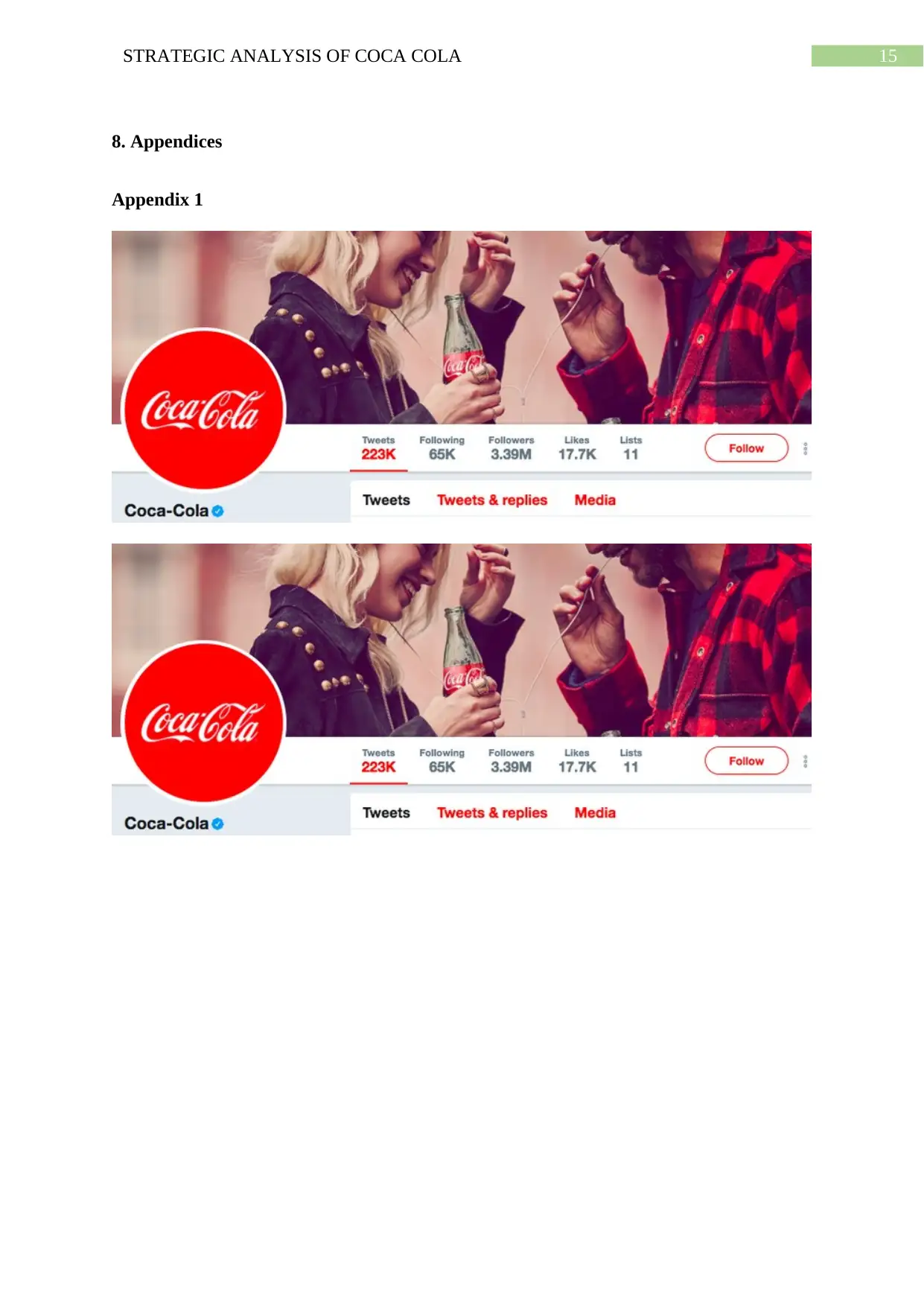
15STRATEGIC ANALYSIS OF COCA COLA
8. Appendices
Appendix 1
8. Appendices
Appendix 1
Secure Best Marks with AI Grader
Need help grading? Try our AI Grader for instant feedback on your assignments.
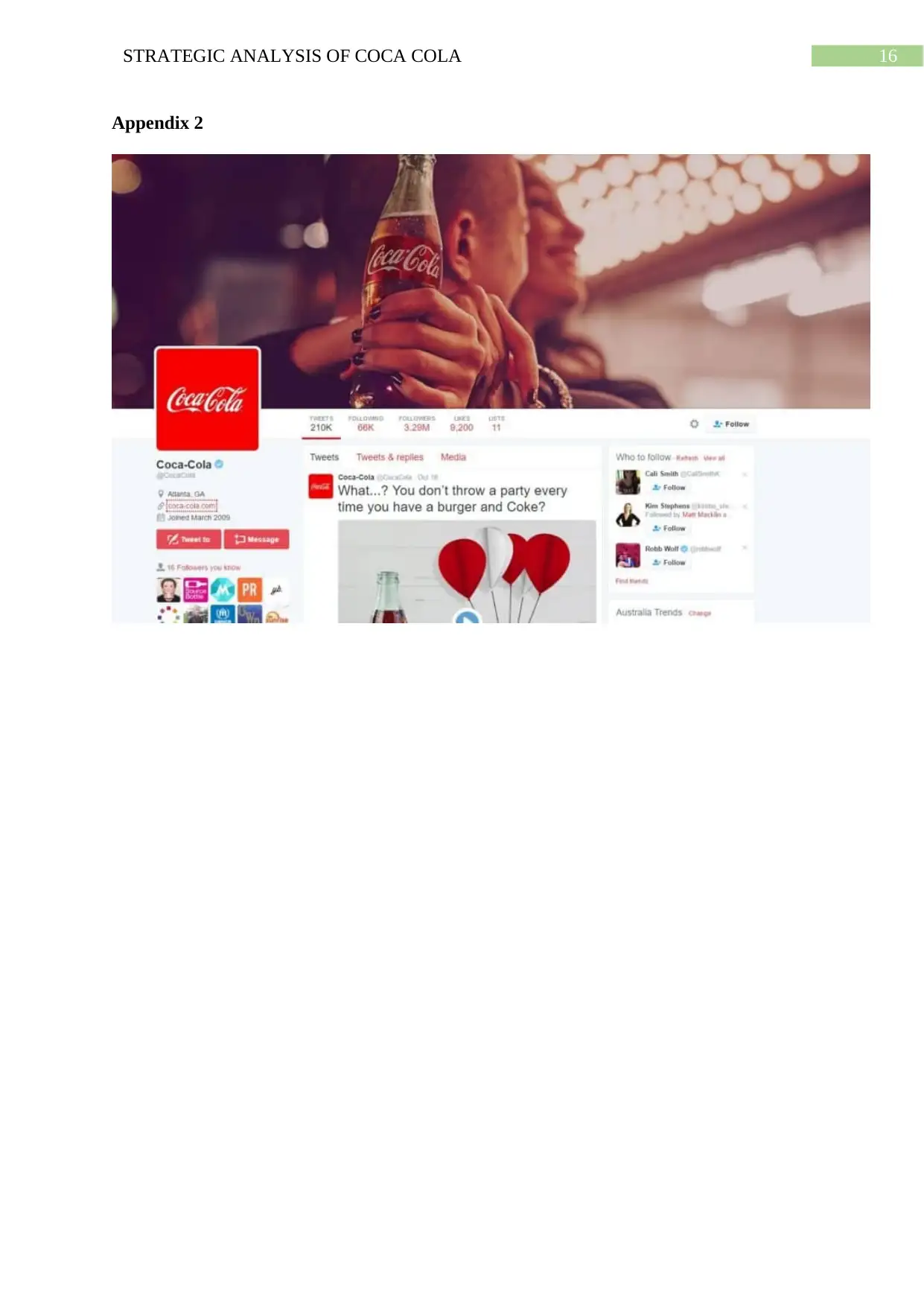
16STRATEGIC ANALYSIS OF COCA COLA
Appendix 2
Appendix 2
1 out of 17
Related Documents
Your All-in-One AI-Powered Toolkit for Academic Success.
+13062052269
info@desklib.com
Available 24*7 on WhatsApp / Email
![[object Object]](/_next/static/media/star-bottom.7253800d.svg)
Unlock your academic potential
© 2024 | Zucol Services PVT LTD | All rights reserved.




